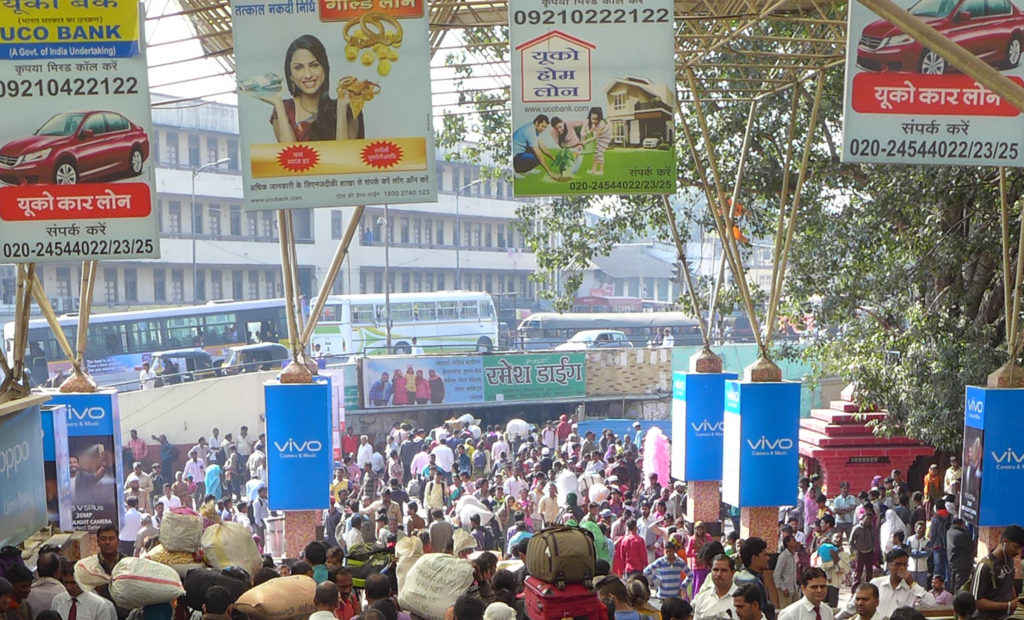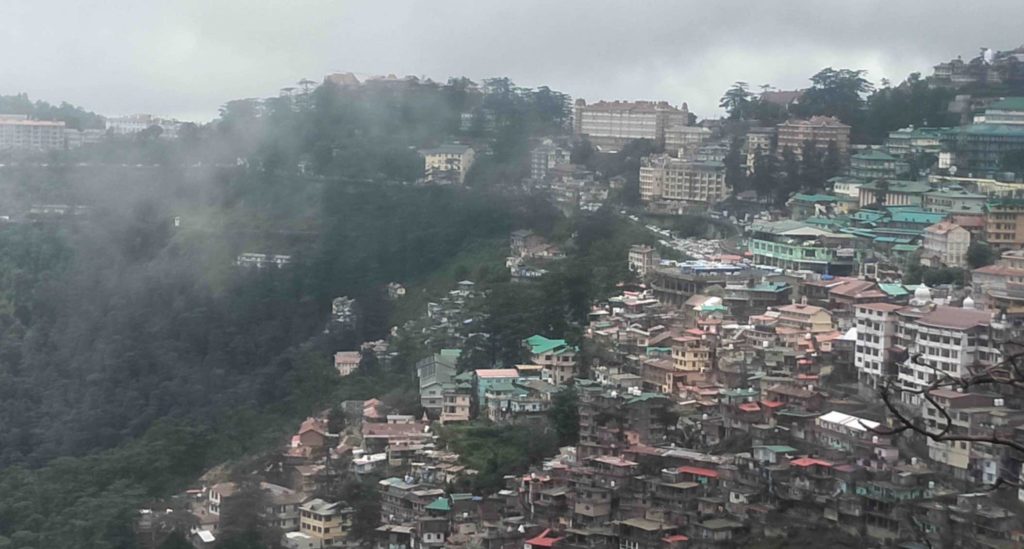In India, studies of agriculture and urbanization have noted significant changes in land use over the last 40 to 50 years, which are linked to heavy migration from the countryside to cities. This in turn is a result of how India has been moving away from agriculture to the industrial and service sectors over the last few decades. Although cities are seen to offer opportunity for marginal communities, India’s metropoles actually offer little social mobility.
Recently, as a result of the COVID-19 outbreak and lockdowns, the apathy of elites and leaders towards the workers who keep the cities running has been starkly exposed. Historically, cities have provided a respite to marginalized communities from the rigidities and atrocities of the caste system, which often prevents them from buying land or starting profitable ventures in their villages.
The city of Pune is located in western India and lies in a fertile basin along the Mula-Mutha watershed in the Sahyadri Mountains above Mumbai. A prime location for agriculture, it was home to only a million people in 1970. Expansion of engineering firms, manufacturing companies, schools and the IT industry drew workers, students, and service providers.

Today, Pune has grown to six million residents, making it India’s ninth largest city. The surrounding countryside has changed from sustainable farms to real estate developments, commercial agriculture, road networks, economic zones, industrial parks, and service facilities. This has resulted in a drastic shift in land ownership patterns, provoking ecological crisis, loss of livelihood, displacement, and disruption of supply systems.
When this change began in the 1980s, a wave of challenges and opportunities evolved. There was a rising demand for land and labour. In Hadapsar, on the eastern outskirts of the city, an acute shortage of labourers resulted. Low-caste Dalits had long lived and worked on profitable sugarcane fields, but they found even better jobs in the city. This led the dominant landowners, in 2001, to form the Magarpatta Land Development Shareholding Company, the first of Pune’s now common apartment cooperatives.
The village of Lonikand, on the northeast side of Pune, had long produced green, leafy vegetables but is now growing sugarcane. This crop is easier to manage, as factories send labourers to harvest and transport it. Many local landowners preferred to rent or sell their estates for commercial ventures, but some resisted.
“My family had migrated to Lonikand near Pune, where there was more social acceptance for lower castes, and bought a piece of agricultural land. We have been producing sufficient cereals and vegetables for the household, as well as to sell,” said Pushpa, a woman farmer, during an interview with our student research team last year. “I want my children to be educated farmers and do not want our land sold off, although there is pressure on my husband currently to sell off our land, by wealthy farmers and contractors.”
Indian political scientist Niranjan Sahoo has written about obstacles that migrants face. In Maharashtra, the state where Pune is located, there was local resistance to in-migrating outsiders who helped transform the state’s economic base. This antagonism was evident in calls to action by the ‘Sons of the Soil’ against the tens of thousands of in-migrating workers, on which urban growth relied.
Successive governments in Maharashtra have been engaging in populist extravagance rather than addressing welfare in any manner, appeasing the dominant Indigenous communities, while being indifferent to the in-migrants. Because migrants don’t vote in the place they have migrated to, they get a raw deal. Local communities dislike any good jobs or livelihood opportunities going to migrants and populist regimes oblige them – something Sahoo has called “vote-bank populism.”
“[T]he politicization of India’s urban spaces – often for vote-bank populism – not only creates exclusionary barriers for new migrants but is also fuelling their gradual disenfranchisement, even with dangerous consequences,” according to Sahoo. “Indeed, what is at stake is citizenship for thousands of migrants who seek to enter cities in search of a better life.”
In 2019, environmental activists in Pune submitted manifestos to the government asking for scrapping of the High Capacity Mass Transit Route, and setting up of a digital repository of trees, mapping of wells, and protection of hills. This road development project is being planned in and around Pune as an elevated six lane corridor passing over 34 junctions.
But during the COVID-19 outbreak, in the spring of 2020, the migration reversed: many hungry labourers and their families were seen trudging along Nagar Road with their meagre belongings through the dusty suburbs of Pune, en route to their home villages, sometimes hundreds of kilometres away in other states. These sad scenes exposed the apathy of the urban elites towards their workers.
Over the past 50 years, similar dynamics have been underway in the city of Simla, nestled in the foothills of the western Himalayas. A smaller city, it had only 55,000 residents in 1971, the year it became the capital of the new state of Himachal Pradesh. Today, like Pune, Simla has increased its population almost five-fold, to about 240,000. Simla is a major tourist destination, drawing visitors seeking to partake in its views of nature and the architecture from the city’s days as the Raj’s summer capital.

One of the vehicles for growth there was the Simla Development Authority (SDA), a city agency formed in 1980. The SDA focused on urban construction projects, such as residential and office complexes and support systems like water-supply. The focus on development tended to ignore planning oversight, leaving the capital at the mercy of unregulated urbanization, resulting in rampant, haphazard growth. Awareness of the problem quickly became apparent, but the remedy took time.
The SDA came to manage lands on the city’s periphery, which led to growth in more residential projects, such as New Simla Township, in 1986, on the other side of the city’s core ridge line. Residents I interviewed in 2015 recalled that there had once been flourishing agricultural fields in the area.
“Our agricultural land had been acquired by the city government in 1986, and many of the people who got plots and or flats were from outside the state of Himachal Pradesh,” said Kusum Thakur, a municipal councillor and member of an agriculturalist family from New Simla. Real estate development continued through the 1990s in other rural peripheries of Simla. The struggle between development and protection crossed party lines.
In 2000, the State of Himachal intervened, declaring 17 forest areas green zones and banning construction in core areas of the city, except for necessary reconstruction. Despite these orders, the building continued. In 2016, the state government brought out a bill to legalize all construction in Simla.
Environmental organizations protested, detailing how illegal building was destabilizing parts of the hillside city and rendering it unsafe. The bill was quashed by the High Court of Simla. The next year, India’s National Green Tribunal banned all construction, stating “that it was the failure of the state government to curb construction that had exposed the Simla Planning Area to extreme vulnerability to natural and man-made disasters.”
The cities we live in are the product of chosen lifestyles, economic policies and development models on one hand, and of desperate or aspirational in-migration for livelihood on the other. Rural spaces have given way to rapid urbanization, as in Pune, while in Simla many forested and historic spaces have been lost.
Sustenance agriculture took a back seat in both Pune and Simla, as government policy favoured real estate or industrial development. Many poor migrants settled in Pune’s suburbs but lost their livelihoods or were dislocated during the COVID-19 lockdowns. In Simla, wealthier migrants from the lowlands and local bureaucrats acquired properties during the late 1980s and the 1990s, displacing farmers from their agricultural lands. More robust policy could have done better by these communities, protecting fragile ecologies that define both cities. Environmentalists in both Pune and Simla continue to advocate for policy that conserves ecology as well as livelihoods.
Today, civil society as well as the government need to play a more proactive role. “The unprecedented emergence of the people’s realization and ecological activism to save our planet in the last few decades began to bring some degree of change in the awareness at the governmental levels as well,” in the words of Dimple Oberoi Vahali, an environmental activist in Simla.
This article is the sixth produced in collaboration between Toward Freedom and the Symbiosis School for Liberal Arts in Pune, Maharashtra, India. For more information, contact Barry Rodrigue <[email protected]> at Symbiosis International University.
Author Bio:
Richa Minocha is an anthropologist and an associate professor at Symbiosis International University, Symbiosis School for Liberal Arts, Pune, Maharashtra, India. She also runs a grassroots organization, Jan Abhiyan Sanstha (Society for People’s Initiatives) in Himachal Pradesh.
